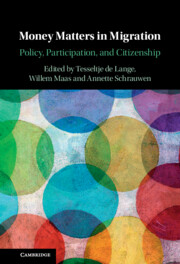Book contents
- Money Matters in Migration
- Money Matters in Migration
- Copyright page
- Contents
- Notes on Contributors
- 1 Money Matters in Migration: A Synthetic Approach
- Part I Migration
- Part II Participation
- 9 “This Is Affordable!” The Role of Money Matters in the Use of Live-In Migrant Care Arrangements
- 10 De-magnetizing the Market: European Integration, Employer Sanctions, and the Crackdown on Undeclared Work
- 11 Women as EU Citizens: Caught between Work, (Sufficient) Resources, and the Market
- 12 Migrant Financial Inclusion versus the Fight against Money Laundering and Terrorist Financing
- 13 Migrant Remittances and Money Laundering in Africa
- Part III Citizenship
- Index
- References
9 - “This Is Affordable!” The Role of Money Matters in the Use of Live-In Migrant Care Arrangements
from Part II - Participation
Published online by Cambridge University Press: 12 November 2021
- Money Matters in Migration
- Money Matters in Migration
- Copyright page
- Contents
- Notes on Contributors
- 1 Money Matters in Migration: A Synthetic Approach
- Part I Migration
- Part II Participation
- 9 “This Is Affordable!” The Role of Money Matters in the Use of Live-In Migrant Care Arrangements
- 10 De-magnetizing the Market: European Integration, Employer Sanctions, and the Crackdown on Undeclared Work
- 11 Women as EU Citizens: Caught between Work, (Sufficient) Resources, and the Market
- 12 Migrant Financial Inclusion versus the Fight against Money Laundering and Terrorist Financing
- 13 Migrant Remittances and Money Laundering in Africa
- Part III Citizenship
- Index
- References
Summary
Care arrangements in which live-in migrant carers care for older people in private households are a growing phenomenon in European countries. This chapter explores the role of money in the emergence and functioning of these arrangements. Comparing Germany and the Netherlands, it combines a governance approach and a coping strategies approach to shed light on the part played by money and financial considerations at different levels. The chapter examines first how laws and policies aimed at ensuring financial sustainability of long-term care systems have provided incentives for the employment of migrant carers in both countries. The emergence of live-in migrant carer arrangements may be an unintended effect of such policies, but policymakers may also tacitly accept the often semi-legal nature of these arrangements as it helps to solve care deficit problems at a low cost for the public budget. Second, the chapter examines the role of financial considerations in the decision-making processes of families making use of these arrangements. How are financial considerations balanced against the quality of the care and the quality of the migrant carers’ working conditions?
- Type
- Chapter
- Information
- Money Matters in MigrationPolicy, Participation, and Citizenship, pp. 149 - 168Publisher: Cambridge University PressPrint publication year: 2021
References
- 1
- Cited by



